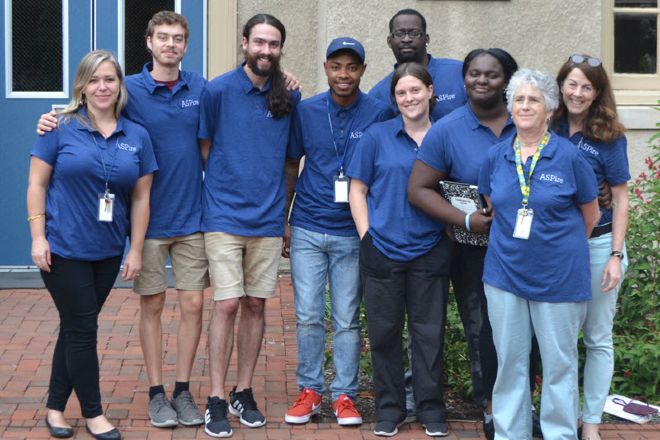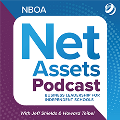Feature image: The after-school programming team at Germantown Friends School in Philadelphia.
It’s not uncommon for schools to see after-school hours as they did 30 years ago — as a time for children to have a snack, play outside and get started on their homework. Yet the amount of time students spend in after-school programs is significant, and as such, a highly significant part of an independent school’s program offerings.
“If a child is enrolled in an after-school program full-time, from preschool through middle school, that child will spend more than 5,400 hours with the members of the after-school team. That's equivalent to four full years of school, which is a lot of homework and graham crackers,” said Page Fahrig-Pendse, associate head of school at Germantown Friends School in Philadelphia, in a recent NBOA webinar.
What can schools do to ensure that those after-school hours spent on campus are meaningful and worthwhile?
Upgrade and Innovate
In recent years, GFS has begun looking at after-school hours differently. The program needs to be “continuously upgraded” to connect with the learning that happens during the school day, said Betsy Neiva, director of auxiliary programming. Neiva and Fahrig-Pendse offered these tips for those seeking to improve after-school programming.
- Assemble a mission-driven team. GFS has a nine-person team that includes people working as teaching assistants, in the cafeteria and as substitute teachers. “We've been able to create stability in our after-school program staff so they're able to commit to us for a longer period of time, and families know them for a longer period of time, which is really crucial,” Fahrig-Pendse said.
- Add value. GFS created ASPire: Afterschool Program, Imagine, Reach, Explore. Each afternoon begins with a presentation about the topic of the day that's related to a theme. It usually involves a short film clip. For example, during “Music Legends” week, students learned about Billy Holiday and Nina Simone. “It's great because the parents tell us that they have these fascinating conversations during the ride home,” Fahrig-Pendse said.
- Have students drive programming. Between 75 and 85 students participate each day at GFS’ after-school programs. They participate in devising things to do. For example, students came up with “Superheroes Week,” which involved making masks and capes, and kryptonite out of Rice Krispie treats. There was a vintage TV week where students were introduced to TV shows like “Superman” and “I Love Lucy.” For the latter, they watched the famous candies-on-the-conveyor belt episode and then built one and tried assembly line work. "It was very humbling for most of them as we adjusted the pace of the conveyor belt itself and the rate. It was organized chaos and a great deal of fun," Fahrig-Pendse said.
- Offer choices. Once the weekly theme is selected, a team member volunteers to be in charge of that week and designs projects for each day of the week — an art project, cooking project and construction project, as well as imaginative play, Legos and Playmobile. Each day the children also have the option of going outside on the playground and doing homework. GFS offers computer use on some days, and "then occasionally we have a dance party," Fahrig-Pendse said.
- Track choices. "The choices that a kid makes is a window into their core personal interests. And what they choose to do with their discretionary time is really significant," Fahrig-Pendse said. GFS keeps a database that shows the choices each child makes each day. "We currently are working on a system for analyzing and sharing this information with parents and teachers, so that they can use this data to help them determine areas that are best suited for future deeper exploration, both inside and outside the classroom," Fahrig-Pendse said.
- Build bridges to school-day programs. For example, members of the school's maker committee visited maker spaces at three area schools to discuss how to incorporate making and designing into the after-school curriculum. Team members also initiate activities to enhance community-service projects.
Make It Public
Parents and students need to know how great the program is. GFS lets them know by taking photos each day and showing them on a big plasma screen centrally located at the school. Students' projects are exhibited in public space. GFS posts any information about the program on a visible bulletin board designated for communication. “Parents will know what their kids have been up to. In addition to that, [it gets] the kids excited about what will be coming next,” Neiva said. They also put up flyers about special projects and promote the special programming on conference days and other in-service days and, of course, they post on social media.
All these innovations add value in the admissions process, Fahrig-Pendse said. “A special bulletin board was created to be a stop on the admissions tours. A vibrant after-school program can be a strong differentiator to parents who need after-school coverage.”
The advancement office, too, is excited about robust after-school programs. “A strong and distinctive after-school program that reflects our mission can be a great talking point for the advancement team members when they meet with these donors,” Fahrig-Pendse said.
For more information and access to the presentation, NBOA members can visit the webinar archive.



